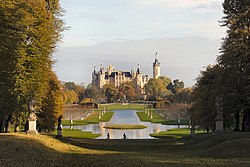County of Schwerin
| Schwerin | |||
|---|---|---|---|

Schwerin Palace - Parliament of Mecklenburg-Vorpommern
|
|||
|
|||
| Coordinates: 53°38′0″N 11°25′0″E / 53.63333°N 11.41667°ECoordinates: 53°38′0″N 11°25′0″E / 53.63333°N 11.41667°E | |||
| Country | Germany | ||
| State | Mecklenburg-Vorpommern | ||
| District | Urban district | ||
| Government | |||
| • Lord Mayor | Rico Badenschier (SPD) | ||
| Area | |||
| • Total | 130.46 km2 (50.37 sq mi) | ||
| Elevation | 38 m (125 ft) | ||
| Population (2015-12-31) | |||
| • Total | 96,800 | ||
| • Density | 740/km2 (1,900/sq mi) | ||
| Time zone | CET/CEST (UTC+1/+2) | ||
| Postal codes | 19053, 19055, 19057, 19059, 19061, 19063 | ||
| Dialling codes | 0385 | ||
| Vehicle registration | SN | ||
| Website | schwerin.de | ||
| County of Schwerin | ||||||||||
| Grafschaft Schwerin | ||||||||||
| State of the Holy Roman Empire | ||||||||||
|
||||||||||
|
County of Schwerin during the time of the Hohenstaufen Emperors (circa 1250)
|
||||||||||
| Capital | Schwerin | |||||||||
| Government | Principality | |||||||||
| Historical era | Middle Ages | |||||||||
| • | Established | 1161 | ||||||||
| • | Partitioned to Schwerin and Sch-Wittenburg |
1279 |
||||||||
| • | Partitioned to create Sch-Boizenburg |
1323 |
||||||||
| • | Inherited Tecklenburg | 1328 | ||||||||
| • | Sch-Schwerin comital line extinct |
1344 |
||||||||
| • | Sch-W'burg-B'burg extinct | 1349 1358 | ||||||||
| • | Comital line extinct; sold to Mecklenburg-Schwerin |
1358 |
||||||||
|
||||||||||
| Bishopric of Schwerin | ||||||||||
| Bistum Schwerin | ||||||||||
| State of the Holy Roman Empire | ||||||||||
|
||||||||||
|
Bishopric of Schwerin during the time of the Hohenstaufen Emperors (circa 1250)
|
||||||||||
| Capital | Schwerin | |||||||||
| Government | Theocracy | |||||||||
| Historical era | Middle Ages | |||||||||
| • | Established | 1062 | ||||||||
| • | Gained territory | 1165 | ||||||||
| • | Secularised to M-Schwerin | 1648 | ||||||||
|
||||||||||
Schwerin ([ʃvɛˈʁiːn] or [ʃvəˈʁiːn], Mecklenburgian Swerin, Latin Suerina) is the capital and second-largest city of the northern German state of Mecklenburg-Vorpommern. The population is 91,583 (as of December 31, 2013) and 98.000 as of July 2016.
Schwerin was first mentioned in 1018 and was granted city rights in 1160, thus it is the oldest city of Mecklenburg-Vorpommern. It is known for its romantic Schwerin Palace, crowning an island in the Lake Schwerin. The city also has a largely intact old town, thanks to only minor damage in World War II.
Schwerin is located within the metropolitan region of Hamburg and close to that of Berlin, and to nearby regiopolises of and Lübeck.
...
Wikipedia






